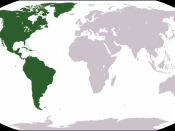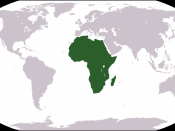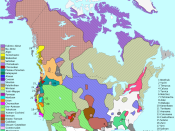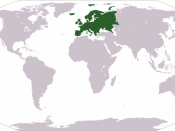The intercontinental exchange began when the Europeans arrived in the Caribbean. It consisted of the intended and inadvertent introduction of pathogens, plants, animals, technology, ideas, and religion between North America, South America, Europe, and Africa. It was a benefit and a detriment to each continentÃÂs people.
Perhaps the biggest catastrophe that occurred due to intercontinental exchange was the spread of pathogens and disease. Europeans and later Africans brought smallpox and a host of other diseases with them to America, where those diseases killed as much as 90 percent of the native population of two continents. Europeans came away lucky, with only a few tropical diseases from Africa and, probably, syphilis from the New World. In America, disease destroyed civilizations (learnnc.org). The spread of syphilis was very rampant. Not clear as to whether it was actually a North American disease; European explorers often passed syphilis back to European countries, mainly within the ports that occupied the coast line.
Malaria was also contracted by the Europeans, most likely from Africa, and then later brought to America as well.
A major exchange between Spain and North America was the idea of Catholicism. When the Spanish conquerors controlled the southwest territories of North America they began to set up mission colonies. These colonies held churches as a place to convert Natives to Catholicism and would later spread up the coast of California. Positive influences also occurred with the exchange of animals such as hogs, sheep, cattle, and most importantly horses. When the Native Americans accidentally came across horses that belonged to the Spanish, they found new ways of hunting and traveling, also warfare was changed because the Indians could now move swiftly on the battlefield making killing and evading much more effective. Hogs, sheep, and cattle were also an important food source for the exchanging countries. However, some of these animals did carry disease with them and in turn killed people that domesticated them for agricultural purposes (learnnc.org). Plants and food were also a positive outcome of intercontinental exchange. New sources of foods that contained necessary vitamins and nutrition were traded amongst the Americas and Europe. Yams, potatoes, and grain to name a few were all introduced around this time.
During the early 1600's, Europeans began to use African slaves in the American colonies. The Europeans obtained slaves from Africans who continued to sell their war captives or trade them for rum, cloth, and other items. Ships from Europe transported goods to the west coast of Africa. There, traders exchanged the goods for slaves. Next, the slaves were carried across the Atlantic Ocean to the West Indies and sold. On another route, ships from the New England Colonies carry rum and other products to Africa, where they were exchanged for slaves. The ships then transported the slaves to the West Indies to be sold. The slave traders used some of their profits to buy sugar and molasses (east-buc.com).
The intercontinental exchange proved both beneficial and harmful for the countries involved. It helped improve the harsh lifestyle of the 1600ÃÂs and shaped America into what it is today.
BibliographyWalbert, David. ÃÂDisease and Catastrophe.ÃÂLearnnc.org. 21 September 2009Woods, Michelle. ÃÂThe Slave TradeÃÂEast-buc.k12. 27 September 2009





